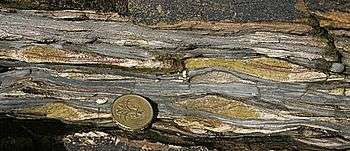Flaser bed
Flaser beds are a sedimentary, bi-directional, bedding pattern created when a sediment is exposed to intermittent flows, leading to alternating sand and mud layers. While flaser beds typically form in tidal environments, they can (rarely) form in fluvial conditions - on point bars or in ephemeral streams.[1] Individual sand ripples are created, which are later infilled by mud during quieter flow periods.[1] These mud drapes are typically a minor constituent of the deposit; they can consolidate within three hours, protecting the underlying layer from erosion.[1] Flaser bedding typically forms in high-energy environments[2][3] but some have also been described in turbiditic sediments reworked by contour currents (Rebesco, 2014).

Flaser bedding, vertical section.
References
- Martin, A.J. (2000). "Flaser and wavy bedding in ephemeral streams: a modern and an ancient example". Sedimentary Geology. 136 (1–2): 1–5. Bibcode:2000SedG..136....1M. doi:10.1016/S0037-0738(00)00085-3.
- Tom Bellile (2003-10-23). "Tidal deposits". (with photograph)
- Reineck, H.E.; Wunderlich, F. (1968). "Classification And Origin Of Flaser And Lenticular Bedding". Sedimentology. 11 (1–2): 99–104. Bibcode:1968Sedim..11...99R. doi:10.1111/j.1365-3091.1968.tb00843.x.
This article is issued from Wikipedia. The text is licensed under Creative Commons - Attribution - Sharealike. Additional terms may apply for the media files.